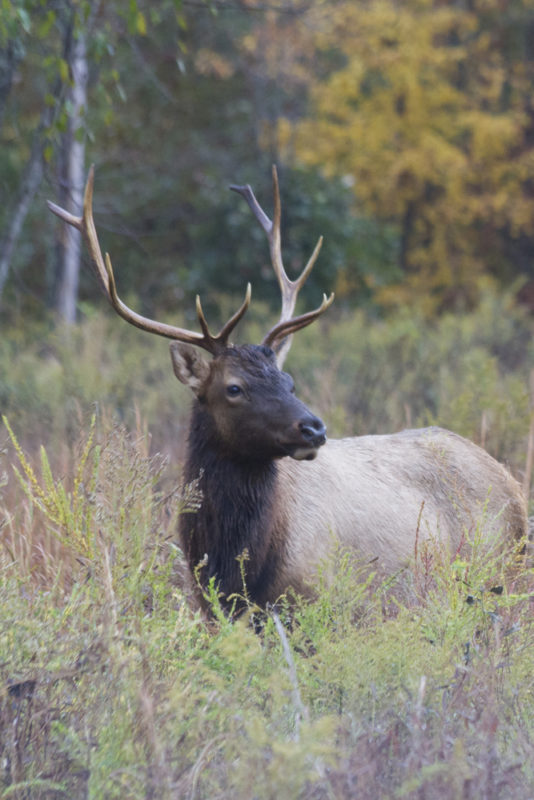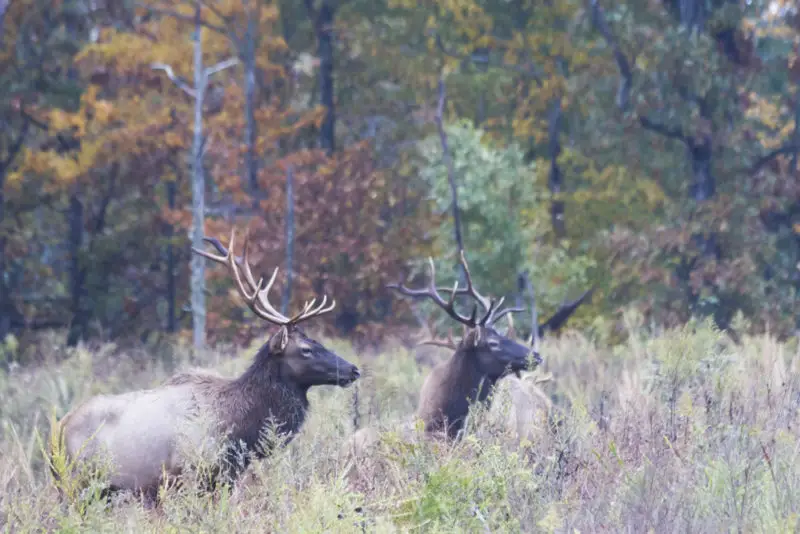Kentucky has the largest elk population of any U.S. state east of the Mississippi River. According to the Kentucky Department of Fish and Wildlife Resources, the elk population within the state is hovering at around 14,407 animals. Source
That hasn’t always been the case, though. Again, according to the KDFWR, the state’s large elk population is a direct result of one of the most successful wildlife restoration efforts ever in the eastern United States.
Also see:
Elk Were Once Extinct In Kentucky
Elk are native to Kentucky as they are too much of the eastern United States. Kentucky is part of the elk or wapiti’s Historic eastern range in North America. The eastern U.S had the eastern elk sub species “Cervus canadensis canadensis”. These animals thrived in the wilds of Kentucky before the arrival of European settlers. However, the arrival of civilization didn’t go well for the eastern elk. Overhunting habitat loss or modification of their habitat eventually drove them to extinction. The last elk was killed in Kentucky before the Civil War.
Restoration of Elk to Kentucky
In the late 1900s, an interest in restoring elk to some of their native range within Kentucky began to take hold. The state had already successfully restored whitetail deer, wild turkey, peregrine falcons, and river otters to some of their original territory within its boundaries.
The KDFWR conducted an in-depth habitat feasibility study. They also held many public hearings to gauge the attitude of the citizens of the state. At the end of this process, they determined that there was a sufficiently feasible elk habitat in a 14-county elk zone in the southeastern counties of the state. This area has a sufficiently large land base, relatively low human population density, and enough public lands to make the project feasible.
Historically, there were also elk in western Kentucky, but this area is now too developed to accommodate elk reintroduction without lots of elk/human conflict.
In 2004, 2 more counties were added to the elk recovery zone to make a total of 16 counties. This was done in order to facilitate a travel corridor between Kentucky’s elk recovery zone and Tennessee’s elk recovery zone.
After this lengthy process, they procured donated elk from the four western states of Arizona, New Mexico, Utah, Oregon, and the two midwestern states of Kansas and North Dakota. Subsequently, elk capture began in 1997.
From there, they released the first elk into the southern Appalachians of eastern Kentucky in December of that same year. Over the next twenty-five years, a total of 1540 elk were relocated into the state. Knott, Leslie, Letcher, Martin, Perry, and Pike counties all had elk releases.
Elk are thriving there due in part to the state’s mild winters and absence of predators other than black bears and coyotes. With over 14,000 animals, Kentucky has the largest elk herd east of the Rocky Mountains. Source
Rocky Mountain Elk Foundation
One of the organizations that elk and other wildlife in Kentucky can thank for its long-time support is the Rocky Mountain Elk Foundation. It is worthy to note that of March of 2022, the Rocky Mountain Elk Foundation has contributed over 2.5 million dollars and countless volunteer hours to research and habitat enhancement within the Kentucky elk recovery zone.
They have partnered with the Kentucky Fish and Wildlife Service on numerous projects that will benefit elk hunters and people who enjoy being outdoors and seeing wildlife.
One of the latest projects happened in January of 2022. It involved Rocky Mountain Elk Foundation volunteers assisting the Kentucky Division of Fish and Wildlife Resources. The project they undertook was to relocate 50 elk from areas of high population density to an area in the Boon National Forest with underutilized potential elk habitat. Source

The Kentucky Elk Recovery Zone
The Kentucky elk zone consists of over 4.1 million acres. It takes in the sixteen counties in southeastern Kentucky. They are as follows.
- Bell County-From Spectrum News 1, It so happens that reclaimed surface mines in southeastern Kentucky coal country make excellent elk habitat. David Ledford and Frank Allen own 12,000 acres of reclaimed coal mining ground in Bell County. They are currently working to develop that land into a non-profit nature preserve that will be open to the public in 2023. They hope to draw nearly 1 million visitors a year partially by billing their reserve as a superior place to view elk. Additionally, they hope to pump $200,000,000.00 annually into the economy of the region. Source
- Breathitt County– The Southfork Elk View Station is located 3 miles south of Jackson, Kentucky, on I15. Its billing says that it allows visitors to view the largest elk herd in Kentucky. Source
- Clay County- Clay County bills itself as the gateway to Kentucky’s elk country and redbud country. The majority of this County lies within Daniel Boone National Forest lands. Source
- Floyd County- Jenny Wiley State Resort Park in Prestonsburg offers elk-watching tours each fall. Source
- Harlan County- According to an October 3rd, 2017, article in the Harlan Enterprise, elk hunters spent approximately $30,000.00 in Harlan County and approximately $727,000 within the region during the previous year’s hunting season. Source This data proves what a great economic impact elk have on local communities in the region.
- Johnson County-
- Knott County- Knott County, Kentucky, bills itself as the elk viewing capital of the east. Additionally, Kentucky’s state record 87 for non-typical bull elk was taken in Knott County.
- Knox county
- Leslie county
- Letcher County
- Magoffin County-
- Martin County-
- McCreary County- The following excerpt is from a February 4th, 2022, article on the Rocky Mountain Elk Foundation website. “The Rocky Mountain Elk Foundation provided funding and volunteer manpower to help the Kentucky Department of Fish and Wildlife Resources (KDFWR) relocate elk into McCreary County. The goal is to expand the state’s herd by moving 30 to 50 animals into the Daniel Boone National Forest, a place where elk rarely ventured previously.” Source
- Perry County- Here’s an excerpt from a January 11th, 2018, article in the Hazard Herald. “On December 18, 1997, seven elk were released in Perry County as part of the Elk Restoration Project. According to data from the Kentucky Tourism Commission, those seven elk were the first to graze on Southeastern Kentucky vegetation in nearly a century.” Source
- Pike county
- Whitley County-Whitley County and McCreary County were added to the elk recovery zone in 2004 to facilitate a travel corridor between Kentucky’s and Tennessee’s elk recovery zones.
Restoration of Elk to their native range in Kentucky has turned out to be a tremendous success. The group of beneficiaries takes in hunters and nonhunters alike. However, without the push and enthusiasm from hunting groups like the RMEF, for example, the restoration project likely wouldn’t have taken place.
Elk Hunting In Kentucky
The first elk hunt in Kentucky since before the Civil War took place in 2001. The state issued six bull elk permits and six cow elk permits. All hunters were successful in harvesting a total of 12 animals that first year. In 2002 and 2003, the state issued the same number of permits.
From those humble beginnings, the eastern Kentucky elk herd has increased manifold. The state sold 594 elk permits in the general drawing.
The scores of the top 10 biggest bull elk taken in Kentucky may be viewed here, on page 9.
Types Of Kentucky Elk Hunting Permits
Elk Recovery Zone General Drawing
Each year, since there are many more applicants than available permits, they conduct a drawing for elk permits within Kentucky’s elk management zone. What follows is the permit type and the amounts sold for each type of permit in the 2022 general quota drawing.
- Bull Firearm – 150
- Cow Firearm – 244
- Archery/ Crossbow (Cow or Bull)- 175
- Youth-Only – 25
The state of Kentucky conducts a straight random drawing. They do not award preference points. An individual can apply for all three permit types but can only draw out one of their applications.
If any individual successfully draws an elk tag, they are ineligible to apply for the drawing for three years.
Out Of Zone Permits
When the Kentucky Department of Fish and Wildlife committed to restoring elk to the state, they made agreements with affected parties, such as the state Farm Bureau, to restrict that restoration to the Kentucky elk restoration zone. This is because, in these 16 counties, elk are less likely to cause human conflict. Consequently, the state sells over-the-counter “out-of-zone permits” to manage and restrict the elk population to the restoration zone.
Landowner-Cooperator Permits
Landowner-cooperator permits are provided to private landowners who open their land to public hunting. Ergo, the state allocates one permit to the private landowner for every 5,000 acres they enroll in a public hunting agreement with KDFWR. In turn, the landowners may sell or give away these permits.
Special Commission Permits
The Kentucky Fish and Wildlife Commission can award up to 10 yearly hunting permits per species for elk, white-tailed deer, wild turkey, and waterfowl. They award these permits to non-profit groups whose focus is on wildlife conservation.
In turn, these non-profit organizations sell the permits to the general public. The funds they obtain from the sale of these permits must be used on wildlife conservation projects within the state of Kentucky.
Voucher Cooperator Elk Permits
The voucher cooperator elk permit program is for individuals who own a minimum of 100 acres. It allows them to build up credits toward obtaining an elk permit by allowing elk hunting public access on their property.
The recipients of voucher elk hunting permits may sell or give away their permit to someone else. Source
Going Into The Future
The reintroduction of elk to Kentucky will greatly benefit all people who enjoy the Kentucky outdoors. That goes for those who enjoy hunting or those who simply enjoy going on elk tours.
Recent Posts
The only venomous snakes in Washington State are Northern Pacific Rattlesnakes. The Northern Pacific Rattlesnake (Crotalus oreganus oreganus) is a sub-species of the Western Rattlesnake. Anyone...
Skunks are not classified as true hibernators. But they go into a state of torpor when the weather gets cold. Skunks are light sleep hibernators, along with opossums, bears, and raccoons. ...

